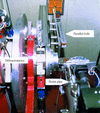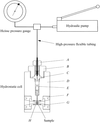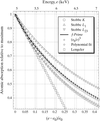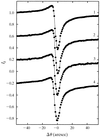issue contents
September 1998 issue

Cover illustration: Deformation electron density sections for YFeO3 and HoFeO3 in the (010) and approximate (100) planes of Fe-Fe and intermediate Fe-R (R = Y, Ho) contacts, see Streltsov, Ishizawa and Kishimoto, pages 1309-1316.
facility information
research papers
This paper reports on the problems encountered and the actions taken at a third-generation synchrotron beamline in order to retain a homogeneous beam and good coherence
High-Focusing Bragg-Crystal Polychromator Design for Energy-Dispersive X-ray Absorption Spectroscopy
The design and characterization of a contoured crystal polychromator for energy-dispersive EXAFS is presented. It gives a full spot between 20 and 40 µm full size in the 5–12 keV energy range.
A description of the experimental apparatus for anomalous wide-angle X-ray scattering (AWAXS) on the GILDA beamline at the ESRF is given.
The design of a high-resolution single-crystal diffraction facility at the SRS, Daresbury Laboratory, is outlined. Several experimental examples are given, including a study of magnetoelastic strain in ferromagnetic US.
A comparative study of the resolution function for 100 µm- and 200 µm-spaced parallel-foil collimators for high-resolution powder diffraction at the synchrotron X-ray source, Daresbury Laboratory.
It is shown for the first time that, similar to single-crystal structure analysis, the lack of inversion symmetry has significant impact on the DAFS signal, so that DAFS may contribute to structure analysis as well.
A hydrostatic pressure cell (maximum pressure 700 MPa) with synthetic diamond windows is applied to quantitatively measure small-angle X-ray scattering of lysozyme at high pressure.
These DOS-Windows running programs for X-ray absorption analysis are written to give the user a tool to undertake all steps of data processing and modelling, rather than making use of the most recent programming facilities. They are in use at the Collaborative Research Group on Interfaces, at the ESRF in Grenoble, France.
The first XMCD measurements carried out on the ID24 energy-dispersive XAS beamline at the ESRF are reported. Circular-polarized X-rays are obtained using perfect diamond crystals as quarter-wave plates.
X-ray reflectivity measurements with a synchrotron radiation source were carried out for thin polymer films on a glass plate. The film thickness and surface and interface roughnesses were determined by curve fitting and Fourier transform procedures.
The deformation electron densities (Δρ) have been determined for synthetic orthoferrites, RFeO3 (R = Y, Ho), using both scintillation and fast avalanche photodiode (APD) detectors for focused synchrotron X-radiation at wavelengths of 0.70 and 0.84 Å. The APD Δρ images indicate strongly that the electron density is perturbed significantly by the cation–cation magnetic interactions.
short communications
A possible source of error on interatomic distance determination in EXAFS multishell data analysis is described.
research papers
Free 



 journal menu
journal menu

































